Douglas Bay Tramway
History
The Douglas Bay Tramway was the brainchild of Thomas Lightfoot, an engineering contractor of Sheffield and latterly the Isle of Man. The first plans were deposited on the 27th November 1875, with Tynwald approving the final version on the 6th June 1876, work commencing the very next day. The relationship between Lightfoot and Tynwald must have been good as materials were ordered in May 1876 before the act had been signed off, and fully three months before it received Royal Assent on the 12th August 1876.
The tramway was built to a gauge of 3ft 0ins, and essentially prescribed an arc along Douglas Bay from the western end of Queen Victoria Pier in the south to the foot of Burnt Mill Hill (now Summer Hill) in the north. The northern two-thirds of the line — between the Iron Pier (which was opposite Broadway) and Burnt Mill Hill — was opened on the 7th August 1876, five days before the enabling act had received Royal Assent, the latter seemingly being treated as a formality. The remaining section of the original line was opened on the 31st January 1877.
From the western end of Queen Victoria Pier, the line ran broadly northwards along present-day Loch Promenade, Harris Promenade, Central Promenade and Queens Promenade to Summer Hill, several of the sections being along roads as a number of the promenades were yet to be built.
Until the 6th January 1882, the tramway was owned by the Lightfoot family; however, following unforeseen additional expenses stemming from Lightfoot's extensive property development activities, the tramway was sold to three local businessmen-cum-speculators. These three quickly formed a company — Isle of Man Tramways Limited — to which they sold the tramway on the 21st March 1882. Although the company appears to have paid too much for the tramway (the initial dividend was only 2%), the company invested fairly heavily during the 1880s, doubling track, purchasing additional horsecars, and on the 8th July 1890, opening a short northern extension along Strathallan Crescent to Derby Castle Gates, taking the tramway to its final size of 1.76 miles.
Apart from its first year, the company paid good dividends throughout the 1880s and early 1890s, but faced the prospect of having the tramway compulsory purchased by Douglas Town Commissions (later Corporation), which had the right to buy the tramway in 1897 under the 21-year rule enshrined in the Tramways Act of 1870. Before this could happen, however, a new tramway appeared at its northern terminus, namely, the Douglas and Laxey Coast Electric Tramway, which commenced its first services on the 7th September 1893. The new electric tramway was initially owned by Douglas Bay Estate Limited, which quickly sold it (in March 1894) to a newly formed company, the Douglas and Laxey Coast Electric Tramway Company Limited. The horse tramway company (Isle of Man Tramways Limited) soon reached agreement with the new company, the horse tramway passing into its hands on the 1st May 1894, on which day it also formally changed its name to the Isle of Man Tramways and Electric Power Company Limited.
The two tramways were now worked as a joint enterprise, and though the lines of the two tramways almost met head on at Derby Castle Gates, they were not connected. A new horse-tram depot was opened at Derby Castle in August 1896, the previous depot having been located on Queens Promenade. The company expanded further on the 15th August 1897 when it opened a new cable-hauled tramway — the Upper Douglas Tramway — which met the tracks of the Douglas Bay Tramway at the junctions of Broadway and Harris Promenade, and Victoria Street and Loch Promenade (the Clock Tower), a connection being made between the tracks at the latter.
The tramway company held negotiations with Douglas Corporation with a view to electrifying the horse tramway, and despite making a formal offer, which the corporation looked favourably upon, it ended up withdrawing it. Disaster struck the company on the 3rd February 1900 when Dumbell's Bank failed, with ruinous consequences for many on the island, largely due to its liberal approach to financing, which included the tramway company. A liquidator was duly appointed, and on the 2nd January 1902, the horse tramway and the cable tramway were sold to Douglas Corporation.
The horse tramway continued to make good profits, though these were often offset completely by losses incurred on the cable tramway. The corporation toyed with the idea of electrifying both lines, but eventually decided against it due to the high costs involved.
Corporation motorbus services were first introduced in 1914, but further expansion was halted by the Great War, the latter also impacting the horse tramway, which saw its services greatly reduced. Further buses were purchased in 1920, with the fleet being continually expanded up until the Second World War; the buses took over winter services from the cable tram in 1921, and replaced it fully following its closure on the 19th August 1929. Financial considerations also led to the withdrawal of winter services on the horse tramway at the end of the summer season in 1929.
The horse tramway closed completely for the duration of the Second World War — between the 1st of October 1939 and the 21st May 1939 — the island being used for internment.
The tramway enjoyed an all-too-brief Indian summer during the post-war boom in tourism, and though still profitable, the ever-spiralling costs of motorbus operation perversely led to calls for its closure, which it only narrowly survived. The downturn in tourism and the burden of local transport provision eventually led to the motorbus operations of Douglas Corporation Transport and the Isle of Man Road Services being amalgamated to form Isle of Man National Transport; the horse tramway was, however, excluded from the agreement.
By 1980, the tramway was continually running at a loss, with passenger numbers falling dramatically during the decade, and by 1990 it was losing circa £50,000 per annum. After years of struggling, in January 2016 Douglas Corporation announced that the tramway would not reopen for the coming summer season, the yearly losses now amounting to a £263,000. However, after significant concerns were voiced, the tramway was eventually nationalised, operation currently being in the hands of Isle of Man Transport.
Uniforms
Photographs of the tramway taken in the twenty-six years prior to the municipal takeover are somewhat sparse, though sufficient in number to state with reasonable certainty that uniforms were not worn, either during the tenure of Thomas Lightfoot or Isle of Man Tramways Limited (i.e., 1876 to 1894). Drivers and conductors simply wore smart yet informal attire, including frock coats and coachmen's hats (drivers), and jackets, straw boaters and bowler hats (conductors).
The situation with respect to the Isle of Man Tramways and Power Company Limited (i.e., from 1894 to 1901/2) is less clear. It is possible that conductors may have been issued with kepi-style caps bearing a large, brass, oval cap badge, as their colleagues on the Douglas and Laxey Coast Electric Tramway certainly wore these. The badge was voided, and comprised: 'IOMT' at the top, 'EPCOLD' at the bottom, and a large '&' in the centre (see below).
Following the corporation take-over, tramcar crews continued to wear informal attire, and had still not been provided with uniforms as late as 1907; however, at some point between 1907 and the Great War, the corporation finally began issuing tramway staff with uniforms. The jackets were single-breasted with five buttons (possibly bearing a municipal device — see link), two breast pockets (with button closures) and stand-up collars; the left-hand collar carried an employee number in individual metal numerals, whereas the right-hand side appears to have been left plain. The tensioned-crown peaked caps bore standard, off-the-shelf, script-lettering grade badges, either 'Driver' or 'Conductor'; the latter were presumably brass to match the buttons. It is currently unclear how long these uniforms persisted, but probably up to and including the Great War. Sometime after this, possibly in the mid-1920s, tramcar crew uniforms were updated to a double-breasted design with five pairs of buttons and lapels, made from dark blue serge. These uniforms were used right through to the mid 1970s, though they were largely superseded by dust coats well before their final demise; the dust coats were possibly beige initially, though later on they were definitely blue. It is possible that the buttons and badges were changed from brass to chrome at some point, though this remains unproven.
By the mid-1970s, the wearing of uniforms appears to have been wholly dispensed with, staff instead wearing whatever shoes and trousers they chose (often jeans and trainers), the sole nod to smartness being a light-blue dust coat, which bore a shield-shaped cloth badge on the breast pocket; the badge appears to have been the standard type that tourists the world over were once fond of attaching to their rucksacks. Hats appear to have been worn only occasionally. In the 1980s, the light-blue dust coats were themselves superseded by shorter and slightly darker-blue dust jackets, which were in turn — in the 1990s — superseded yet again by dust coats, this time of a more intense blue, with the pocket edges and the shoulders embellished with red and white flashings.
In the 2000s, a more restrained uniform policy appears to have been followed, with crews wearing dark trousers and polo shirts (it is unclear whether these were issued by the corporation), but with hi-visibility jackets in a variety of lurid colours.
Photographs suggest that tramcar drivers may have been required to wear a licence badge issued by Douglas Corporation; these were white on blue enamel, with 'CORPORATION TRAM DRIVER' around the circumference, and a number in the centre (see below for an example). It is unclear how long these licence badges were in use for, or indeed whether conductors were required to wear a similar badge. Photographs taken in the 1920s and 1930s show no sign of licence badges being worn, so the requirement was evidently dropped at some point. However, licence badges made a comeback in 1951, and were worn through to the mid 1970s. These badges were were orange and white, and were of the standard PSV pattern introduced nationally in 1935; they bore a number, a grade (either 'CONDUCTOR' or 'DRIVER') and 'BOROUGH OF DOUGLAS TRANSPORT'.
Photographs of senior staff are rare, however, those that have survived indicate that they wore double-breasted jackets with four pairs of buttons and lapels; after the Second World War, but possibly prior to that too, the collars bore the grade — 'INSPECTOR' — in embroidered block capitals. The tensioned-crown peaked caps probably also bore a small embroidered grade badge, though this is unclear.
Unlike the vast majority of British tramways, Douglas appears not to have employed women during the Great War, whilst during the Second World War, the tramway was closed for the duration.
Further reading
For a history of Douglas Bay Tramway, see "The Douglas Horse Tramway" by Keith Pearson; Adam Gordon Publishing (1999).
Images
Horse tram drivers and conductors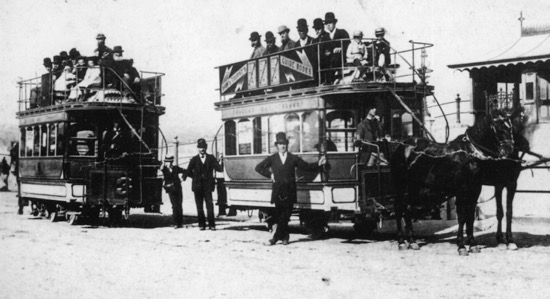
Tramcars No 2 (right) and No 3 (left) captured outside the Iron Pier — photograph believed to have been taken on the opening day, i.e., the 7th August 1876. All present are wearing smart but informal attire, including both drivers (one on the platform of No 2 and the other with his hand on No 2's stanchion) and conductors (one leaning nonchalantly on No 3's dash, sporting a straw hat, and the other on No 3's platform. Photo courtesy of the Tramways and Light Railway Society, with thanks to David Voice.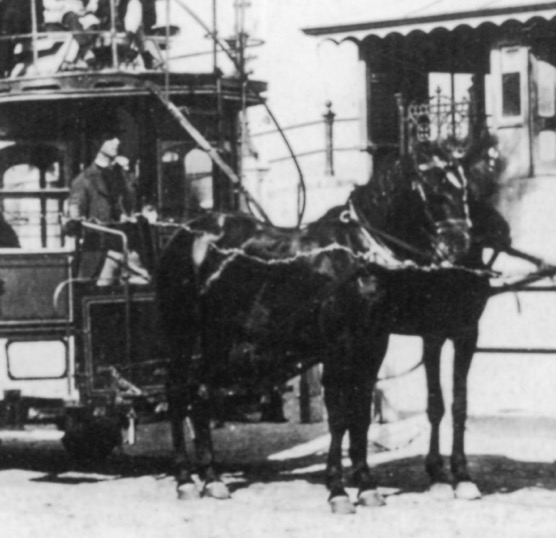
An enlargement of the above photograph showing the driver of Tramcar No 2. He is wearing a three-quarter length jacket and a tall coachman's hat.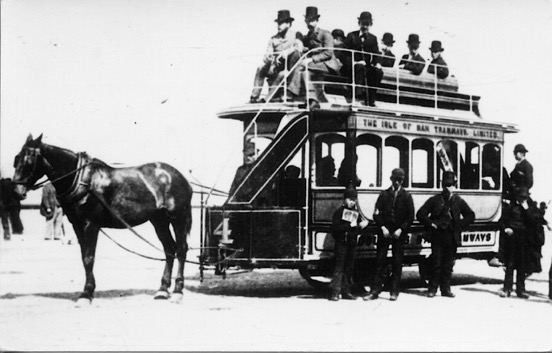
Tramcar No 4 — a Starbuck product — and an assemblage of tramway employees and customers in Isle of Man Tramway Company days, very probably taken directly after the take-over of 1882. Photo courtesy of the Tramways and Light Railway Society, with thanks to David Voice.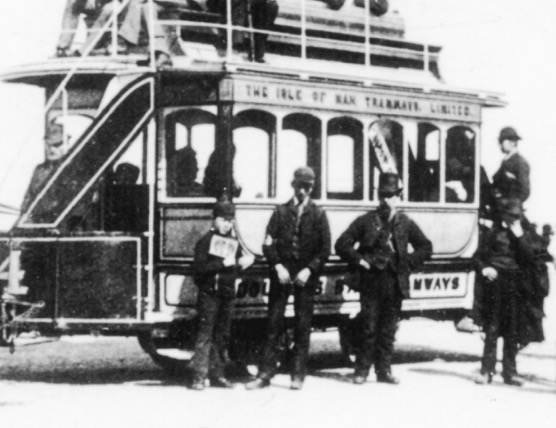
An enlargement of the above photograph showing some of the figures in more detail — all, including the driver, who is wearing a coachman's hat, are wearing informal attire. The man in the centre appears to be wearing an oval armband, almost certainly a licence badge of some description.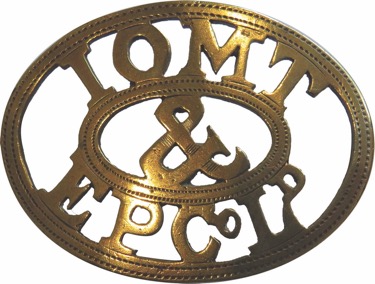
A brass Isle of Man Tramways and Power Company Limited cap badge; this was potentially worn by horse-tramway conductors between 1894 and 1901/2, though there is currently no photographic evidence to either confirm or refute this. Photo courtesy of Manx National Heritage.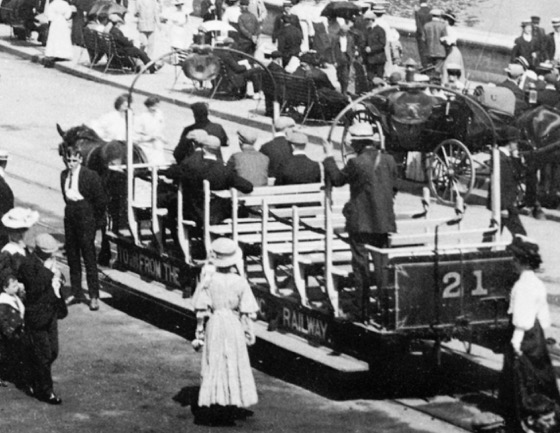
A crowded seen taken just opposite the Jubilee Clock in 1902, so a good six months after the corporation takeover. The conductor, standing on the rear platform, is wearing informal attire, along with a light-coloured panama-style hat. Photo courtesy of the Tramways and Light Railway Society, with thanks to David Voice.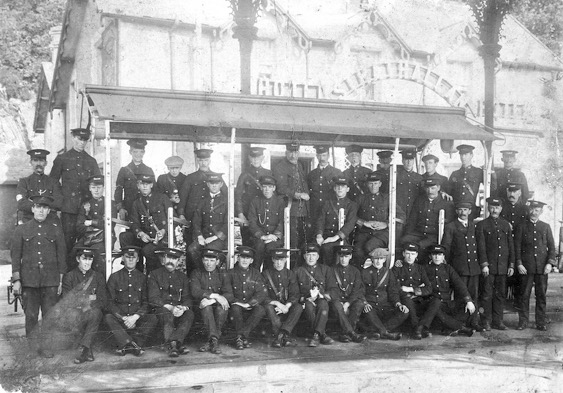
A large group of Douglas Corporation conductors, drivers, and a single inspector, assembled around Horsecar No 22 — photo undated, but probably taken in 1910. Photograph believed to originate from the Keith Pearson Collection. 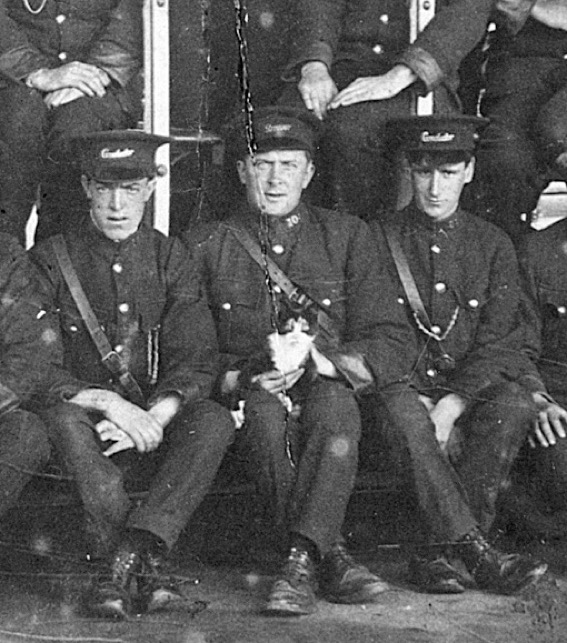
An enlargement of the above photograph showing two conductors and a driver, the latter holding a moggy and wearing a conductor's cash-bag strap. The men's right-hand collars appear to be devoid of insignia, whereas the left-hand collars bear employee numbers. The caps bear standard, script-lettering grade badges, either 'Driver' or 'Conductor'.
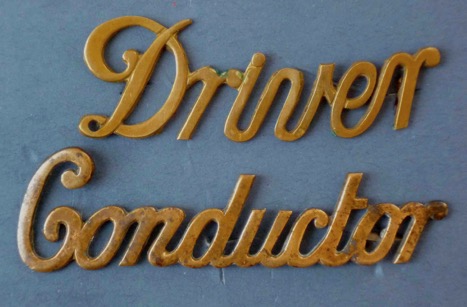
General pattern script-lettering cap badges of the type issued to staff working the Douglas Corporation Tramways horsecars — brass.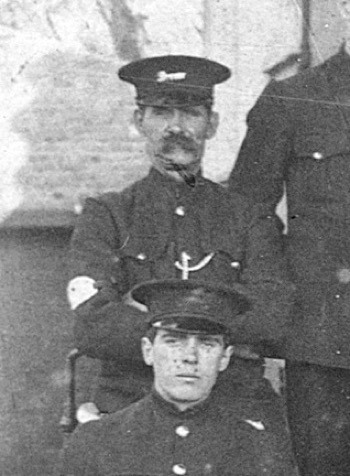
Another blow-up of the above photograph, this time showing a driver, who is clearly wearing an oval armband.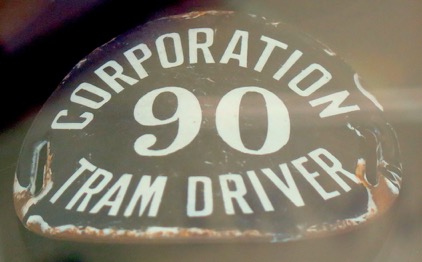
An oval driver's licence badge — white on blue enamel — possibly worn from around 1890 through to the early 1950s. The badge is held in the Manx Museum. Photo courtesy of Rob Jones.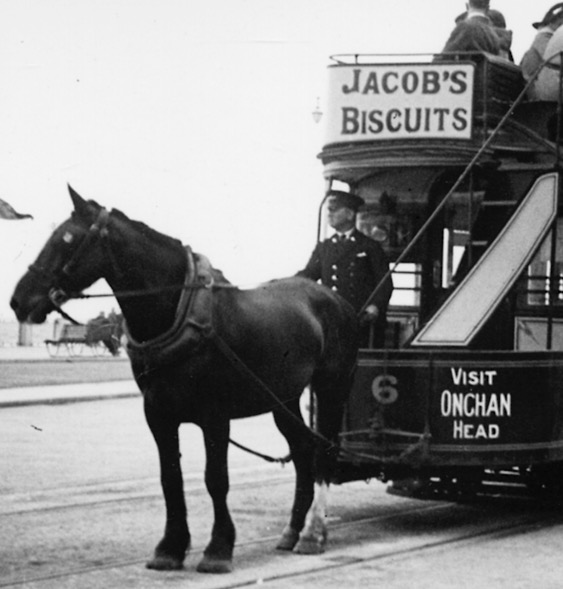
Judging by the livery, a pre-1926 view of Tramcar No 6. The driver is wearing a smart double-breasted jacket, and tensioned-crown peaked cap with a script-lettering grade badge. Photo courtesy of the Tramways and Light Railway Society, with thanks to David Voice.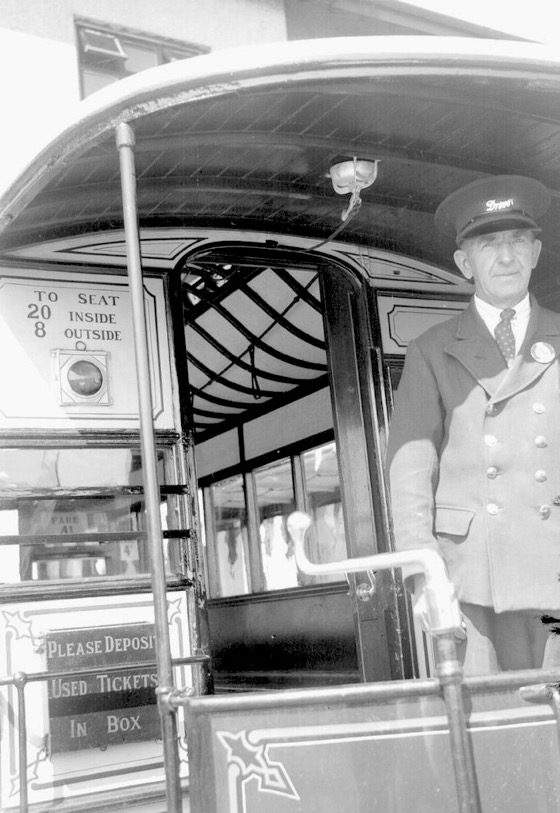
The driver of Horsecar No 1 poses for the camera of D W K Jones in May 1951. With thanks to the National Tramway Museum. 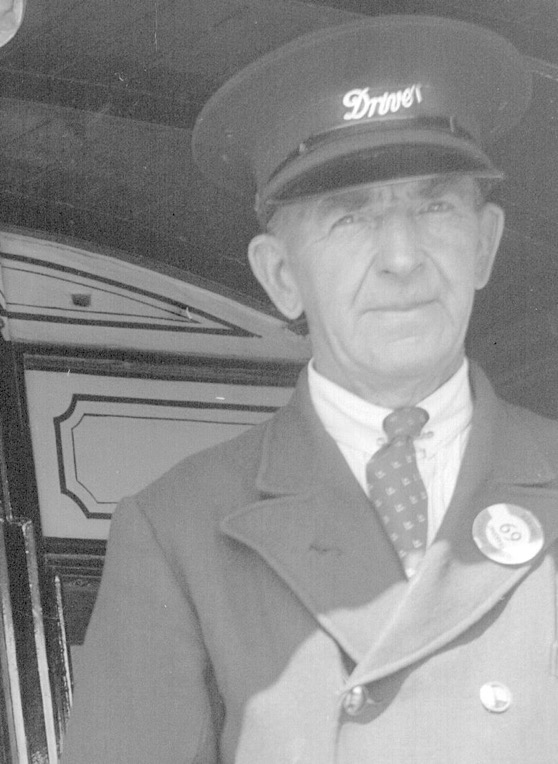
An enlargement of the above photograph showing details of the driver's smart, double-breasted uniform and municipal PSV licence badge (No 69).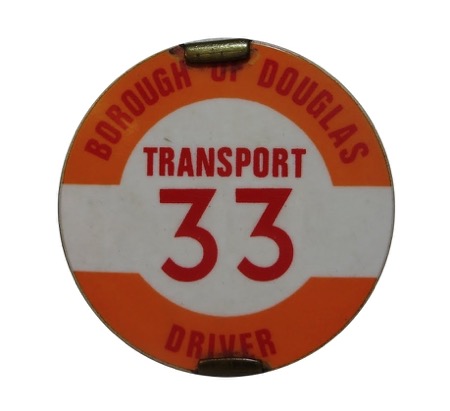
Borough of Douglas Transport driver's PSV licence badge (No 33), as worn by horse tram drivers. With thanks to the Stephen Howarth Collection.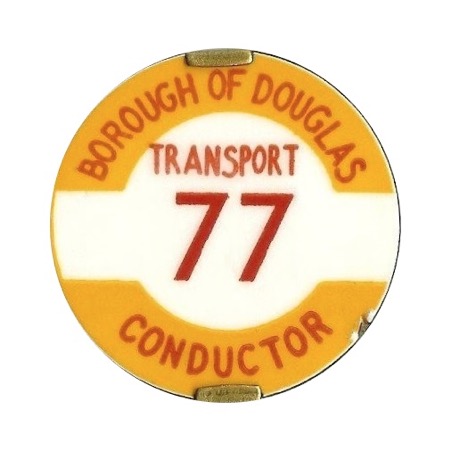
Borough of Douglas Transport conductor's PSV licence badge (No 77), as worn by horse tram conductors. With thanks to the Stephen Howarth Collection.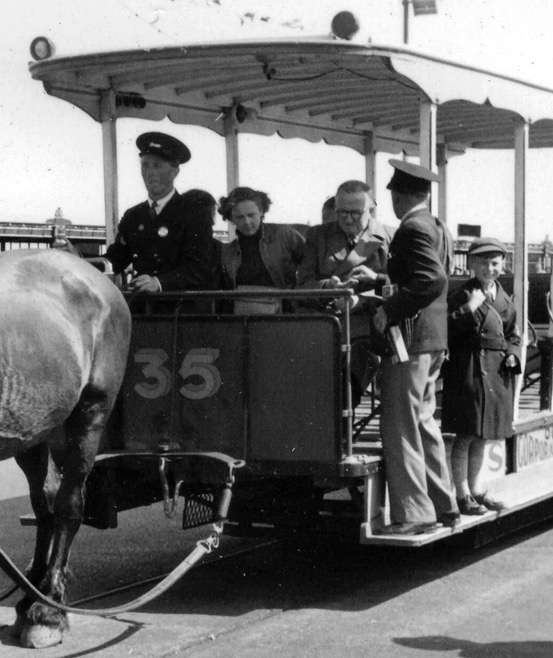
A driver and a conductor captured with Tramcar No 55 by the camera of A W Monk in 1955.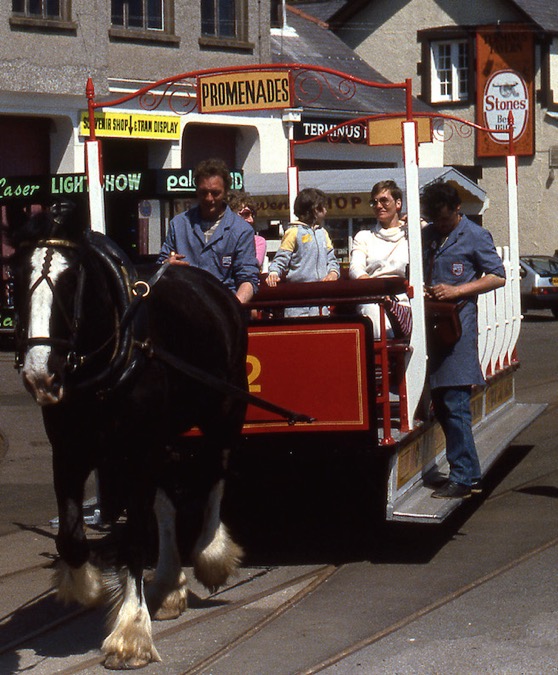
Tramcar No 12 in single-deck condition and without lamps, pictured outside the depot — photo undated, but certainly taken in the early-to-mid 1970s. Both men are wearing long, blue dust coats with what appear to be sew-on shield-shaped cloth badges, of the type once commonly sold in souvenir shops the length and breadth of the land. Photo courtesy of the Tramways and Light Railway Society, with thanks to David Voice.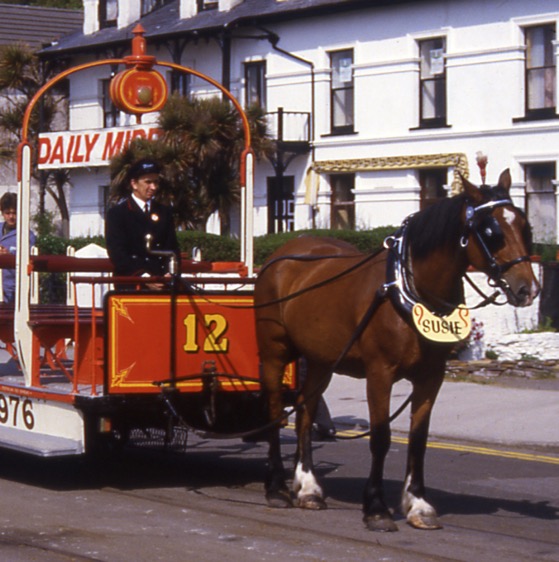
A colour photograph of a DCT driver at the helm of Tramcar No 12, which was restored to near original condition for the centenary celebrations of 1976. The photograph clearly shows that the smarter blue serge jackets and the Borough of Douglas licence (on his left lapel) were still available when needed. Photo courtesy of the Tramways and Light Railway Society, with thanks to David Voice.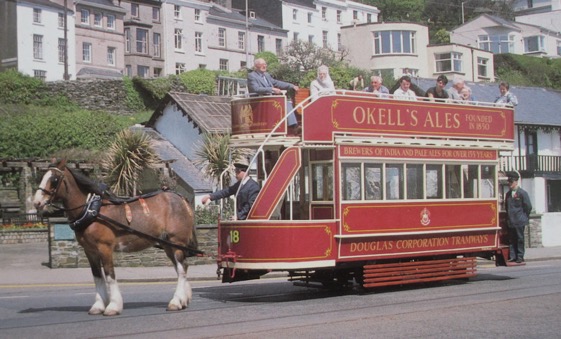
Tramcar No 18 with newly restored upper deck, strongly suggesting that the photograph was taken following out-shopping in 1989. Photo courtesy of the Tramways and Light Railway Society, with thanks to David Voice.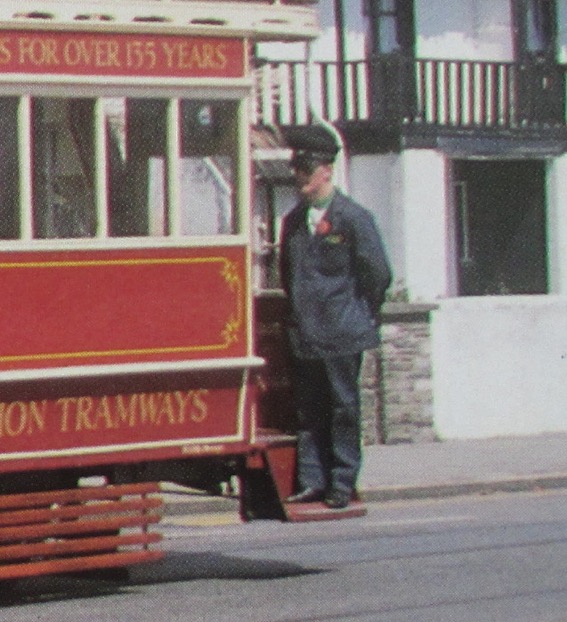
An enlargement of the above photograph showing the short, blue dust jackets that were worn in the late 1980s.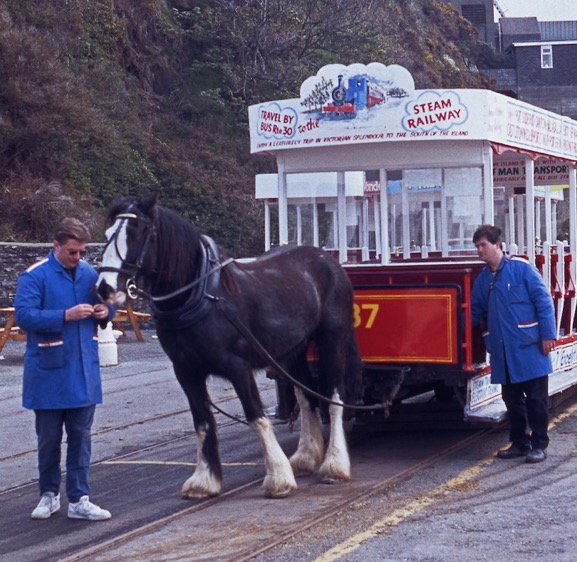
A driver and a conductor with Tramcar No 37, looking anything but smart in lurid blue dust coats (with red and white flashings) — photo undated, but almost certainly taken in the 1990s. Photo courtesy of the Tramways and Light Railway Society, with thanks to David Voice.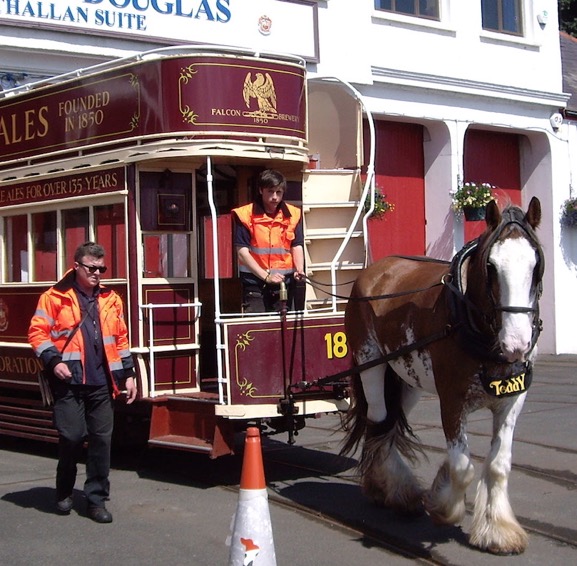
A conductor and a driver manoeuvre restored Tramcar No 18 out of the depot on the 4th August 2012, both men wearing orange hi-vis jackets. Photo courtesy of the Tramways and Light Railway Society, with thanks to David Voice.
Senior staff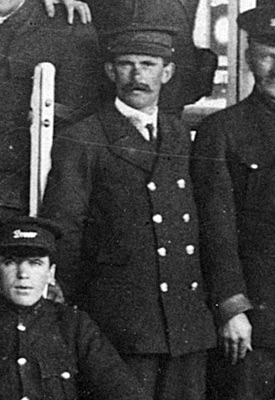
An enlargement of the pre-Great War staff photograph above showing an inspector, in double-breasted jacket, seemingly devoid of insignia, and with a cap that probably bears his grade.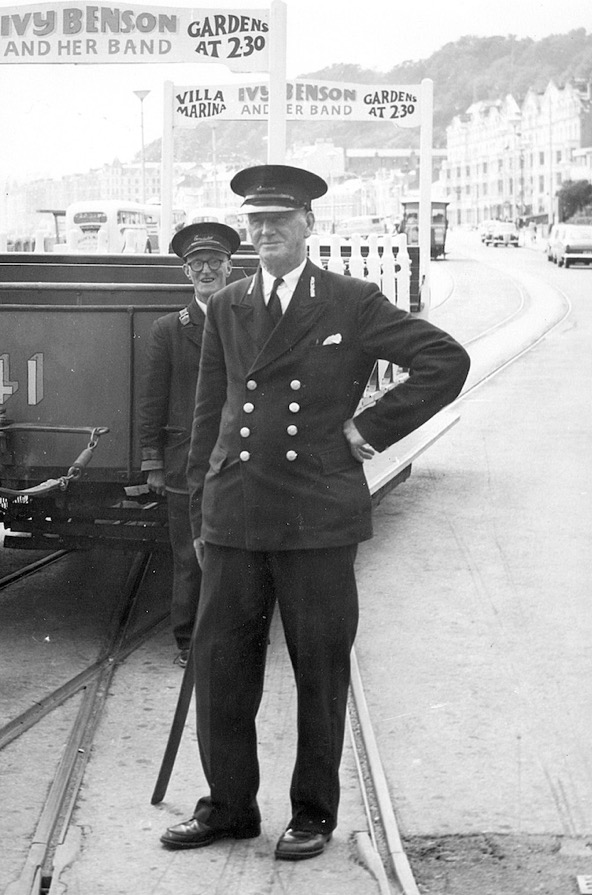
Inspector Jack Dugdale captured with Horsecar No 41 around 1967. Photograph believed to originate from the Keith Pearson Collection.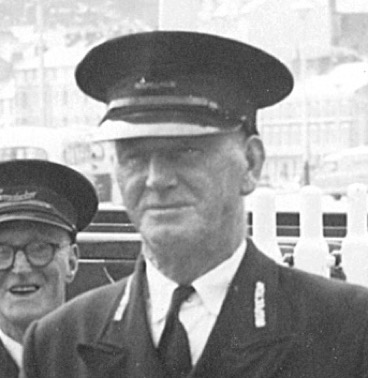
An enlargement of the above photograph, revealing the lapel insignia to by embroidered block capitals — 'INSPECTOR'. The situation with the cap is less clear.